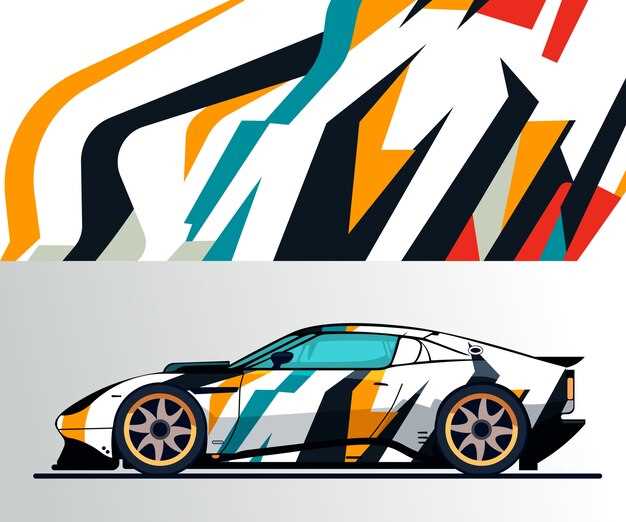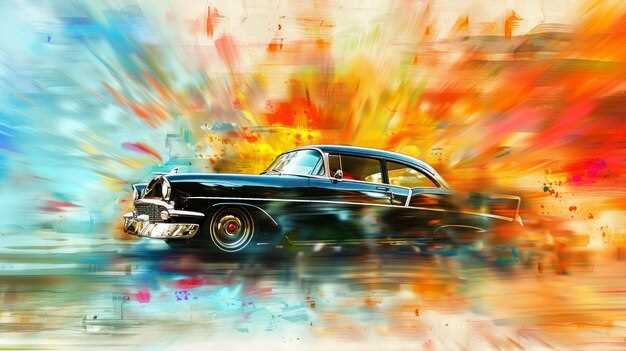
Race Car Wraps vs. Paint – What’s Better?
- George Harris
- 0
- Posted on

In the world of automotive customization, the debate between race car wraps and traditional paint jobs is one that generates significant discussion among enthusiasts and professionals alike. Both methods offer unique advantages and considerations, making it essential to evaluate their features before deciding on the best option for your racing vehicle. In this article, we will explore the merits of each approach, highlighting their impact on aesthetics, cost, and longevity.
Race car wraps have risen in popularity due to their versatility and ease of application. With a wide array of colors, patterns, and finishes available, wraps allow car owners to express their creativity and individuality without the permanence of paint. However, the question of durability and long-term performance remains a crucial factor. Are these vinyl coverings capable of withstanding the rigors of racing, or will they succumb to wear and tear more quickly than a classic paint job?
On the other hand, traditional automotive paint boasts a long-standing reputation for resilience and professional finish. While paint offers a wide range of customization possibilities, the application process can be lengthy and expensive, often requiring specialized skills. This brings forth important considerations regarding cost and maintenance in the competitive racing scene. As we delve deeper into this comparison, we aim to provide a comprehensive analysis that will aid racers in making informed decisions about their vehicle’s appearance.
Race Car Wraps or Paint: Which Is Superior?
Choosing between race car wraps and paint is a critical decision for many motorsport enthusiasts and professionals. Both options offer unique advantages and disadvantages that cater to different needs and preferences.
One significant advantage of car wraps is their versatility. Wraps allow for a wide range of customizable designs, colors, and finishes, making it easier to create eye-catching graphics that can promote a brand or showcase a team’s identity. They can be printed with intricate designs and vibrant colors that may be challenging to achieve with traditional paint. Additionally, wraps can be easily removed or replaced, making it simpler to update a car’s appearance without the need for an extensive repainting process.
On the other hand, paint provides a more durable and long-lasting finish. High-quality automotive paint can withstand harsh conditions, including exposure to UV rays, chemicals, and abrasions, which can extend the life of the car’s appearance. Paint jobs can also enhance the car’s resale value, as potential buyers often perceive a well-painted vehicle as more valuable compared to one with a wrap. Furthermore, paint generally offers a more premium look and feel, appealing to enthusiasts who prioritize aesthetics and craftsmanship.
Cost is another critical factor. Car wraps tend to be less expensive than high-end paint jobs, especially when considering the labor involved in preparation and application. However, the long-term costs are essential to consider; while wraps may initially save money, they may require replacement every few years, whereas paint, if maintained properly, can last a decade or longer without significant deterioration.
In terms of installation, wraps can be applied relatively quickly, often completing the process in a matter of days, while painting may take more time due to drying and curing processes. However, the skill level required for a high-quality wrap installation should not be underestimated, as improper application can lead to bubbles, wrinkles, or peeling over time.
In conclusion, the choice between race car wraps and paint ultimately depends on individual needs, budget, and aesthetic preferences. Wraps offer flexibility and cost-effectiveness, while paint delivers durability and a premium appearance. Each option has its merits, and understanding these differences is crucial for making an informed decision.
Cost Comparison: Wraps vs Paint
When considering the application of graphics or color changes to a race car, the cost plays a significant role in the decision-making process. Both vehicle wraps and paint have distinct price ranges and factors that influence their overall expenses.
Vehicle Wraps: Typically, the cost of a professional vinyl wrap ranges from $2,000 to $5,000 depending on the size of the vehicle and the complexity of the design. Custom designs, high-quality materials, and installation by experienced professionals can drive the price up. However, wraps can be a more economical option when considering that they can last between 5 to 7 years with proper care, and their removal is relatively easy, allowing for future changes without damaging the underlying paint.
Paint: On the other hand, a high-quality paint job can start at around $3,000 and escalate to $15,000 or more for custom finishes or professional setups. The expense is influenced by the paint type, surface preparation, and labor involved. Quality paint jobs can last longer, often over a decade, but they are permanent, making changes or repairs more complicated and costly.
Additionally, it is crucial to consider maintenance costs. Vehicle wraps are generally easier to clean and require less frequent maintenance than paint, which may need polishing and waxing to maintain sheen and protection. Over time, this could offset differences in initial costs.
Ultimately, the choice between wraps and paint depends on budget, desired longevity, and personal preference regarding design flexibility. Evaluating both options thoroughly will help determine which is the superior choice for your race car needs.
Durability and Maintenance for Race Car Graphics
When considering race car graphics, the longevity and upkeep of the chosen medium are crucial factors. Vinyl wraps and paint each have unique characteristics affecting their durability and maintenance.
Vinyl Wraps are known for their impressive resilience against various environmental elements. High-quality vinyl is often resistant to UV rays, which can cause fading over time. Typically, well-maintained wraps can last anywhere from 3 to 7 years, depending on exposure and care. To maintain their appearance, regular washing with gentle soap and water is recommended. Avoiding harsh chemicals or abrasive materials is essential, as these can deteriorate the vinyl surface.
On the other hand, Paint provides a more permanent solution, with proper application lasting well over a decade. However, paint requires a more intensive upkeep regimen to maintain its gloss and integrity. Frequent waxing and sealing are necessary to protect against scratches and contaminants. Additionally, factors like stone chips and weather conditions can lead to peeling or discoloration, necessitating touch-ups or full resprays.
In terms of maintenance ease, vinyl wraps have a slight advantage, as they can be repaired or replaced without affecting the original surface of the car. In contrast, repairing painted surfaces can be labor-intensive and may not blend perfectly with existing paint.
Ultimately, the choice between wraps and paint should consider personal preference, budget, and the desired level of maintenance. Both options can provide stunning visuals, but their requirements for durability and upkeep vary significantly.
Customization Options: What Each Method Offers
When considering the choice between race car wraps and paint, it’s essential to understand the customization options each method provides. Both approaches offer unique benefits and opportunities for personalization.
Race Car Wraps
Race car wraps use vinyl materials that can be printed with high-quality graphics. The customization options for wraps include:
- Graphic Design: Custom designs can include logos, patterns, and intricate graphics. Wraps allow for vibrant colors and detailed imagery that can attract attention on the track.
- Color Variety: Wraps come in a wide array of colors and finishes, including matte, gloss, and chrome, giving owners the ability to achieve unique looks that stand out.
- Text and Branding: Easy incorporation of text elements like driver names and sponsorship details enhances the car’s identity and representation.
- Temporary Designs: Wraps can be changed frequently. This enables teams to update their designs based on seasonal themes, sponsors, or marketing campaigns.
- Protection: The vinyl acts as a protective layer for the car’s original paint, reducing the risk of scratches and environmental damage.
Paint

Paint may offer a more traditional approach, but it also brings its own set of customization options:
- Color Depth and Finish: Paint can provide deep, rich colors and various finishes, such as metallics and pearlescents, resulting in a striking appearance.
- Custom Artwork: Complex, hand-painted designs allow for a high level of artistry, ideal for custom projects where precise, unique artwork is required.
- Durability: High-quality paint can be applied with durable finishes that withstand harsh conditions and wear, ensuring longevity.
- Seamless Integration: Paint offers a more integrated look, which can be beneficial for certain design concepts, especially where contours and shapes are critical.
- Value Addition: A professionally finished paint job can enhance the overall value of the car, making it more attractive to potential buyers or sponsors.
In conclusion, both race car wraps and paint offer distinct customization options, catering to varied preferences and purposes. Consider the specific requirements of your project when choosing the best method for your race car.
